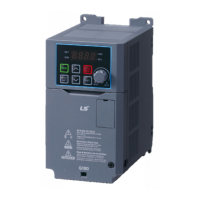5 Learning Advanced Features
This chapter describes the advanced features of the G100 inverter. Check the
reference page in the table to see the detailed description for each of the application
features.
Auxiliary frequency
operation
Use the main and auxiliary frequencies in the predefined
formulas to create various operating conditions. Auxiliary
frequency operation is ideal for Draw Operation* as this
feature enables fine-tuning of operation speeds.
Jog operation is a kind of a manual operation. The inverter
operates to a set of parameter settings predefined for Jog
operation, while the Jog command button is pressed.
Uses the upper and lower limit value switch output signals
(i.e. signals from a flow meter) as Acc/Dec commands to
motors.
3-wire operation is used to latch an input signal. This
configuration is used to operate the inverter by a push
button.
This safety feature allows the inverter’s operation only after
a signal is input to the multi-function terminal designated for
the safety operation mode. This feature is useful when extra
care is needed in operating the inverter using the multi-
purpose terminals.
Use this feature for the lift-type loads such as elevators,
when the torque needs to be maintained while the brakes
are applied or released.
This feature ensures that the motor rotates at a constant
speed, by compensating for the motor slip as a load
increases.
PID control provides automatic control of the inverter’s
output frequency for the purpose of constant automated
control of flow, pressure, and temperature.
Used to automatically measure the motor control
parameters to optimize the inverter’s control mode
performance.
Sensorless vector
control
An efficient mode to control magnetic flux and torque without
special sensors. Efficiency is achieved through the high
torque characteristics at low current when compared with
the V/F control mode.
Used to maintain the DC link voltage for as long as possible
by controlling the inverter output frequency during power
interruptions, thus to delay a low voltage fault trip.
Used to save energy by reducing the voltage supplied to

